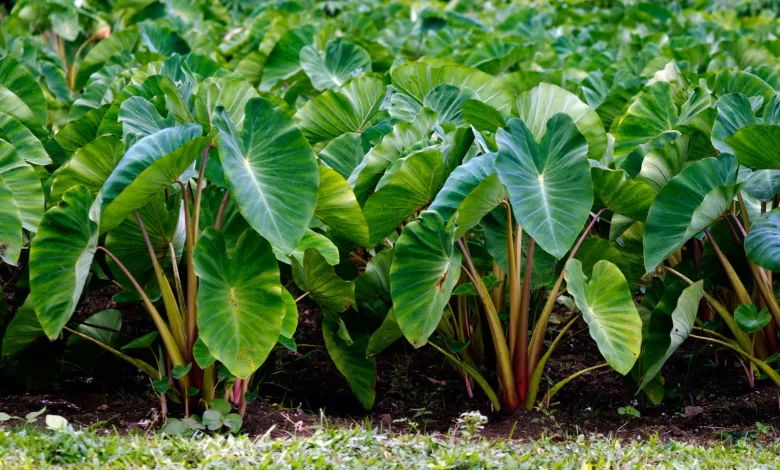
Taro root is a perennial herbaceous tropical or subtropical plant that you can usually grow for its starchy but sweet flavoured tuber. It is also called “eddo,” “dasheen,” and “Kalo” and can grow in various regions around the world. Farmers grow the taro plant from 1 metre to 2 metres tall. Their leaves are elongated and light green, and the heart shape seems like an elephant’s ear. “Colocasia esculenta” is the botanical name that belongs to the “Araceae” family. Taro root is used as a cooked dish, and its fresh leaves are also consumed in India.
Process of Taro Root Farming
It is very easy and simple to start a taro root farming business both on a commercial and small scale. Taro root trees generally require little care. So, you will probably be able to start and operate this business efficiently, even if you are a beginner. Taro root trees typically grow in regions with relative moisture and full sun availability. Farmers require the essential equipment to complete the process. The tractor is the most predominant part of farming, so you can choose the Eicher 548 tractor and many more. This guideline describes more details about taro root cultivation, from planting, care, and essential information.
Growing Taro Root – Climatic Requirements
You can grow the taro root throughout the year in frost-free weather conditions. However, The Taro crop thrives best in moist and warm conditions. Evenly distributed rainfall is conducive for its cultivation and proper growth. In dry or draught, low-rainfall areas, one should give supplemental irrigation. You can expect the best growth from 25°C to 35°C.
Taro Root Production – Soil Requirements
You can grow the taro root in a wide range of soils with the best organic matter. Well-drained soil with a pH range of around 5.5 to 7 is ideal for its growth. You should avoid the rocky or stony soils if the soil does not have enough nutrients; the use of organic matter is recommended at the time of soil preparation. You should do the soil testing before sowing to ascertain the health of the soil.
Taro plantation – Preparation of land
You require a couple of deep ploughings to make the field soft textures so that the roots effortlessly develop and grow in the soil. While preparing the soil, remove the weeds. Apply compost or any organic matter to make soil rich.
Commercial Taro Root Crop – Irrigation Requirement
You should have the soil moist enough with good drainage and make sure taro root plants are well irrigated. Farmers require frequent irrigation in dry or drought conditions. You should avoid waterlogging in the rainy season. For better water management, adapt a drip or sprinkler system.
Weed Control and Intercultural Operations
The taro root crop matures in about 9 to 12 months when the leaves turn yellow and die, and the tubers can be seen to be slightly raised. Since taro root is not stored for more than a month, leaving the tubers in any soil is recommended until they are no longer needed.
Taro Care and Maintenance
- You should keep taro planting beds weed-free.
- You should keep the planting bed moist.
- In early spring, plant pre-germinated tubers with protection using a plastic tunnel or cloche.
- Farmers grow the plants in greenhouses, which need to be misted frequently.
Taro root Plants – Pests and Diseases
The main pests in taro root cultivation are aphids and red spider mites that can attack the taro roots grown indoors. The main diseases in taro root cultivation are leaf blight and downy mildew. Leaf blight causes circular spots on the leaves.
Taro Varieties to Grow
- There are different varieties and forms of taro; Some with purple leaves or purple veins in the leaves, some grow in wet conditions, and some grow in dry conditions.
- Taro varieties are grouped through the color of their flesh—from pink to yellow and also convert to white.
- Trinidad dasheen thrives well in the United States.
How to Harvest Taro
- Farmers harvest the taro tubers about 200 days after planting when leaves turn yellow and start to die.
- Before the first frost in autumn, lift taro roots such as sweet potatoes.
- You can pick the taro leaves as soon as you open the first leaf. Harvest the taro leaves and never strip the plant of all its leaves.
- You can boil taro tubers like spinach or fry them like potatoes.
Taro Quick Growing Tips
- Taro is a subtropical or tropical plant that needs warm temperatures–77° to 95°F (25-35°C) and also consistent moisture to thrive.
- Farmers grow the taro root best in USDA zones 9-11.
- You can grow the taro root for its tubers only where summers are long–at least 200 frost-free, warm days.
- You can grow the taro root for its leaves in a greenhouse.
Tractor Requirement in Taro Root Farming
The tractor is an indispensable aspect of taro root farming. The tractor is used in every segment of agriculture practice. Because as a start the tillage process in agriculture, you need the tractor, and till the harvesting the plant, you need it in this farming. Therefore, a tractor has become the primary factor in farming but choosing the right one is not easy. Hence we recommend the Kubota mu4501 tractor for cultivation and you can buy the popular tractor brand.
For more information regarding taro root farming in India, stay tuned with us.



